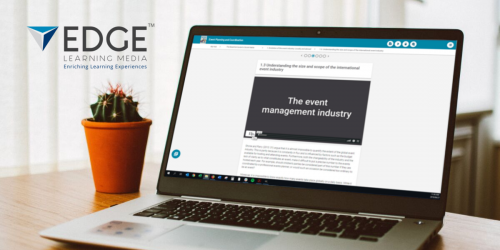Multimedia and learning
‘People can learn more deeply from words and pictures than from words alone.’
This statement by Mayer [a] (2014) is the multimedia learning hypothesis, which encapsulates the importance of using multimedia in learning.
Mayer defines multimedia as information that is presented in both words and pictures. These words include printed and spoken texts, while pictures refer to both static and dynamic graphics (e.g. images and videos). Multimedia learning is the process of creating mental representations from these words and pictures in computer-based environments.
Throughout history, information has primarily been communicated through verbal modes of instruction. The same has applied to the learning process. Today, however, we live in a technology-driven society – multimedia is king, and learning is no longer confined to lecture halls and printed textbooks.
According to the International Society for Technology in Education (2016), technology is being used not simply to complement learning and teaching, but to transform it. As such, we need to understand how multimedia learning resources should be designed, in order to promote learning.
How does multimedia learning work?
To explain this process, Mayer (1997) developed the cognitive theory of multimedia learning (CTML). This describes how multimedia instruction should be designed and, in addition, which cognitive strategies can be employed to optimise learning (Sorden, 2013).
Three assumptions
According to Mayer and Moreno [a] (1998), the CTML is underpinned by three assumptions, which are based on principles of cognitive science.
1. The dual-channel assumption
This assumption states that working memory comprises two distinct channels – an auditory/verbal channel and a visual/pictorial channel (Mayer [a] and [b], 2014). This principle is based on Paivio’s dual coding theory and Baddeley’s model of working memory.
2. The limited capacity assumption
The second assumption is based on Sweller’s cognitive load theory. It states that each of these channels in working memory has limited capacity, in terms of how much information can be processed simultaneously (Sorden, 2013). This means that working memory can become overloaded.
3. The active processing assumption
The third assumption suggests that learning is an active process, whereby knowledge is constructed in meaningful ways. This entails selecting which information one should pay attention to, organising this information into coherent mental representations, and integrating these representations with prior knowledge (Mayer, 1999; Mayer and Moreno [b], 1998; and Sorden, 2013).
Multimedia instruction and cognitive load
The limited capacity assumption is one of the key concepts of the CTML, as it implies that the capacity of working memory can be exceeded. This means that when cognitive overload occurs, learning is impaired (De Jong, 2010).
Expanding on Sweller’s cognitive load theory, DeLeeuw and Mayer (2008) propose a triarchic model of cognitive load. This consists of three types of cognitive processing: extraneous, essential and generative. These three types of processing correspond with Sweller’s three types of cognitive load, namely extraneous, intrinsic and germane (Sweller et al., 1998).
1. Extraneous processing (extraneous cognitive load)
This refers to cognitive processing that fails to achieve the objectives of a lesson (Mayer [b], 2014). For example, a learner might pay attention to quirky, colourful animations in a video, rather than focusing on the information being conveyed in the video. This detracts from the educational value of the multimedia learning material, which is, according to Mayer, indicative of poor instructional design.
2. Essential processing (intrinsic cognitive load)
Mayer [b] (2014) defines this as the basic cognitive processes that are required in order to mentally represent material in working memory. Imagine the following scenario: A learner is watching a video explaining the third law of thermodynamics. The video progresses more and more quickly, while the content becomes increasingly complex. Unless the learner is a physics student, the amount of essential processing required to understand this content is likely to exceed their cognitive capacity. Mayer [a] (2014) attributes this overload to the complexity and pace of the lesson, as well as to the learner’s lack of familiarity with the material.
3. Generative processing (germane cognitive load)
The third type encompasses the deeper cognitive processes that are required for making sense of learning materials (Mayer [b], 2014). Specifically, it involves organising materials into coherent structures, and integrating these structures with prior knowledge (Sorden, 2013). According to Mayer [a] (2014), generative processing results from one’s motivation to make an effort to learn.
Consider another example: A learner is watching a short video clip on marketing management. The audio is a monotonous and uninteresting machine recording. Additionally, the content is presented in an overly academic and formal manner. The learner quickly gets bored and turns off the video. In this example, the learner might have the cognitive capacity to process the material, but they lack the motivation to do so. Naturally, this problem can be addressed by increasing the learners’ motivation.
Mayer [c] (2014) has subsequently summarised the key goals of the CTML as follows:
These goals have, in turn, informed the development of research-based principles for multimedia learning. In other words, when multimedia learning resources are designed with these principles in mind, effective multimedia learning can be achieved.
The bottom line
In today’s Digital Age, we are constantly receiving messages in two or more forms – and the same is true for the educational space. As such, it is vital to understand how the use of multimedia impacts the learning experience. To echo Mayer [c] (2014), learning cannot be regarded as something that is imposed on an individual from the outside world. In stark contrast to traditional behaviourists, cognitivists like Mayer believe that people play an active role in the learning process. Based on this, it naturally follows that more meaningful learning occurs when multimedia messages are designed ‘in ways that are consistent with how the human mind works’ (Mayer [c], 2014).
References
De Jong, T. (2010), ‘Cognitive load theory, educational research, and instructional design: some food for thought’. Instructional Science 38(2): 105–134.
DeLeeuw, K. E. and Mayer, R. E. (2008), ‘A Comparison of Three Measures of Cognitive Load: Evidence for Separable Measures of Intrinsic, Extraneous, and Germane Load. Journal of Educational Psychology 100(1): 223–234.
International Society for Technology in Education (2016), Redefining learning in a technology-driven world: A report to support adoption of the ISTE Standards for Students. Washington, DC: ISTE Standards.
Mayer, R. E. (1997), ‘Multimedia learning: Are we asking the right questions?’ Educational Psychologist 32(1): 1–19.
Mayer, R. E. (1999), ‘Research-based principles for the design of instructional messages: The case of multimedia explanations’. Document Design 1(1): 7–19.
Mayer, R. E. [a] (Ed.) (2014), The Cambridge Handbook of Multimedia Learning. 2nd edn. New York, NY: Cambridge University Press.
Mayer, R. E. [b] (2014), ‘Research-based principles for multimedia learning’. Harvard Initiative for Learning & Teaching [website] <https://hilt.harvard.edu/files/hilt/files/mayerslides.pdf> accessed 19 June 2019.
Mayer, R. E. [c] (2014), ‘Research-based principles for multimedia learning’. Harvard Initiative for Learning & Teaching [website] <https://hilt.harvard.edu/event/richard-e-mayer-uc-santa-barbara> accessed 22 June 2019.
Mayer, R. E. and Moreno, R. [a] (1998), ‘Cognitive theory of multimedia learning: Implications for design principles’. ACM SIGCHI Conference on Human Factors in Computing Systems. Los Angeles, CA.
Mayer, R. E. and Moreno, R. [b] (1998), ‘A split-attention effect in multimedia learning: Evidence for dual processing systems in working memory’. Journal of Educational Psychology 90(2): 312–320.
Sorden, S. D. (2013), ‘The cognitive theory of multimedia learning’. In Irby, B. J., Brown, G., Lara-Alecio, R. and Jackson, S. (Eds.) Handbook of Educational Theories. Charlotte, NC: Information Age Publishing.
Sweller, J., Van Merrienboer, J. J. G. and Paas, F. G. W. C. (1998), ‘Cognitive architecture and instructional design’. Educational Psychology Review 10(3): 251–29.



